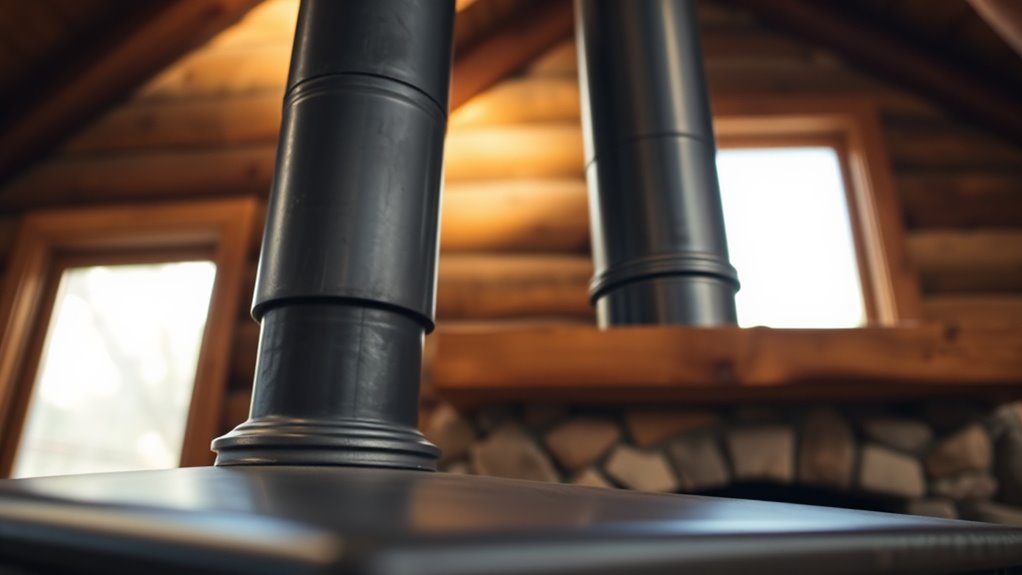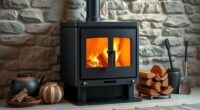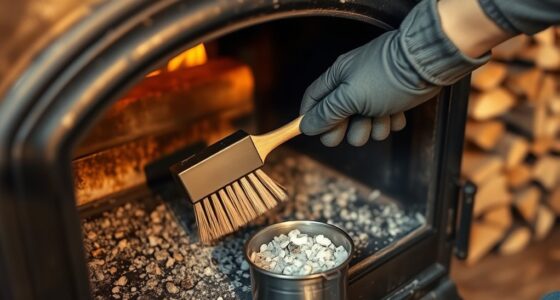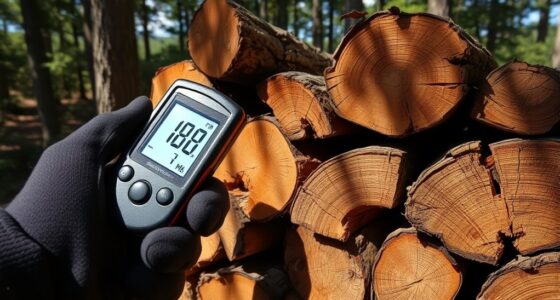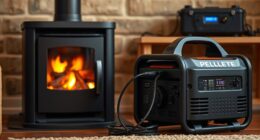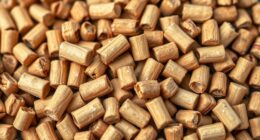Choosing the right flue for your wood stove guarantees safe, efficient venting and enhances stove performance. You should match flue size to your stove’s BTU output, consider durable materials like stainless steel, and ensure proper height and placement for ideal draft and safety. Proper sealing, insulation, and regular maintenance prevent buildup and hazards. Avoid common mistakes like improper installation or neglecting regulations. Keep these tips in mind, and you’ll gain a solid understanding of how to select and install the best flue.
Key Takeaways
- Match flue size to stove output: 6 inches for up to 40,000 BTU, larger for higher BTU ratings.
- Choose durable, heat-resistant materials like stainless steel or clay-lined flues for longevity.
- Ensure proper chimney height—at least 3 feet above roofline and 2 feet above nearby structures for optimal draft.
- Use insulated or double-wall flues to improve efficiency and prevent creosote buildup.
- Follow local building codes and install chimney caps and draft controls to enhance safety and performance.
Understanding the Importance of a Proper Chimney System
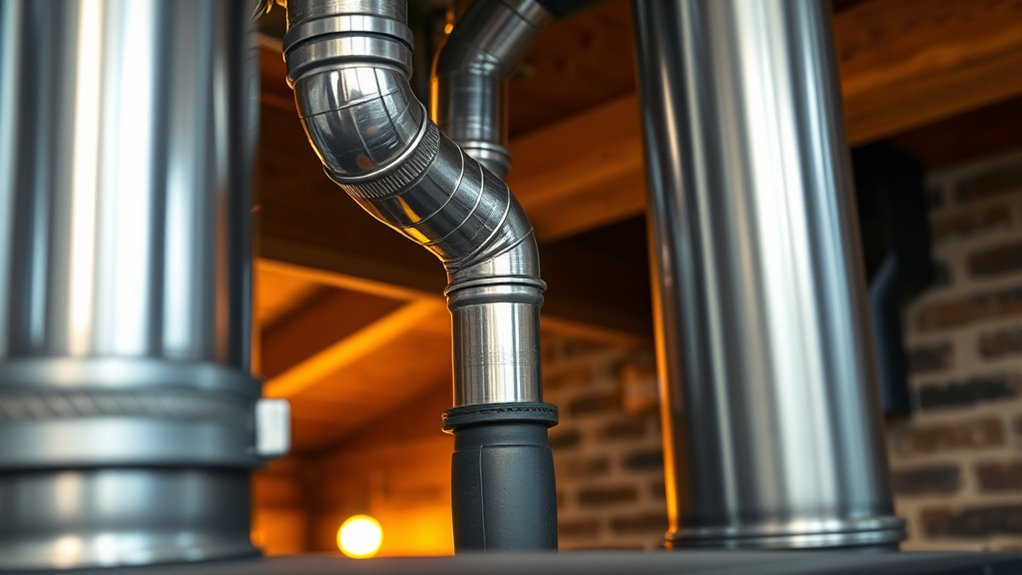
A proper chimney system is vital for safely venting smoke, gases, and byproducts produced by your wood stove. The chimney cap plays an essential role by preventing debris, animals, and rain from entering the chimney, which can cause blockages or damage. Inside, the smoke chamber directs smoke smoothly into the flue, reducing creosote buildup and improving draft efficiency. Without a well-maintained chimney cap, your system risks leaks and obstructions, posing safety hazards and decreasing stove performance. Properly installed and maintained components ensure that harmful smoke and gases exit your home safely, protecting your indoor air quality. Additionally, self-watering plant pots are an example of innovative home solutions that help maintain consistent moisture levels with minimal effort. Remember, a reliable chimney system isn’t just about compliance; it’s about keeping your home safe and your stove functioning efficiently.
Types of Wood Stove Flues and Their Features
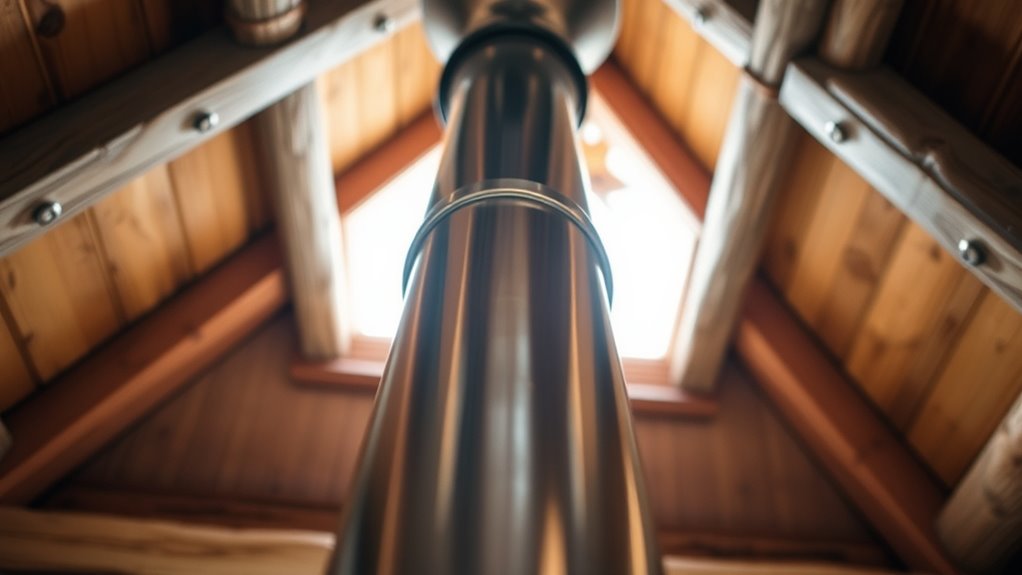
Choosing the right type of wood stove flue is key to guaranteeing efficient and safe venting. There are several options, each with unique features to take into account.
| Type | Features | Best For |
|---|---|---|
| Single-wall | Simple, affordable, limited insulation | Small, well-insulated spaces |
| Double-wall | Better insulation, safer, reduces heat loss | General use, safety-conscious |
| Stainless Steel | Durable, corrosion-resistant, versatile | Long-term, harsh conditions |
| Class A Chimney | Insulated, high-temperature rated | Larger stoves, long runs |
Adding a chimney cap can prevent debris and animals, while draft control ensures proper airflow. Choose based on your stove’s needs.
Factors to Consider When Selecting a Flue Material
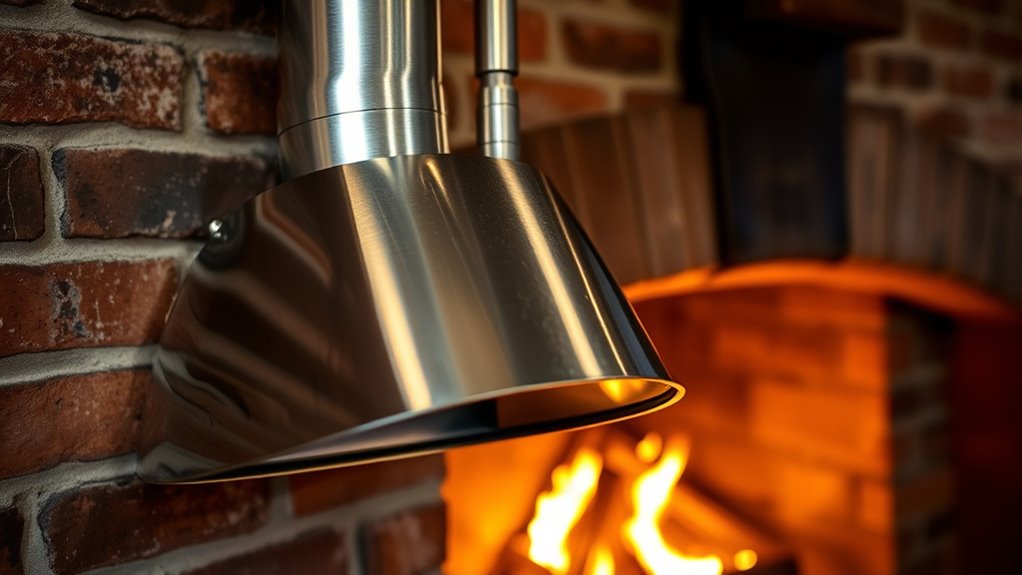
When selecting a flue material, you need to contemplate factors like durability, heat resistance, and compatibility with your stove’s specifications. The right material impacts chimney aesthetics and makes flue cleaning easier. Consider these factors:
- Material durability to withstand high temperatures and corrosion
- Heat resistance ensuring safety and longevity
- Compatibility with your stove’s chimney aesthetics for a seamless look
- Ease of flue cleaning to maintain efficiency and reduce buildup
- Cost and installation requirements to fit your budget and space constraints
- Additionally, choosing materials that match your home’s interior style can enhance the overall appearance of the space.
Choosing the appropriate flue material ensures safe operation, maintains your chimney’s appearance, and simplifies maintenance. Prioritize materials that balance performance with ease of care for a reliable, attractive setup.
Determining the Correct Flue Size for Your Stove
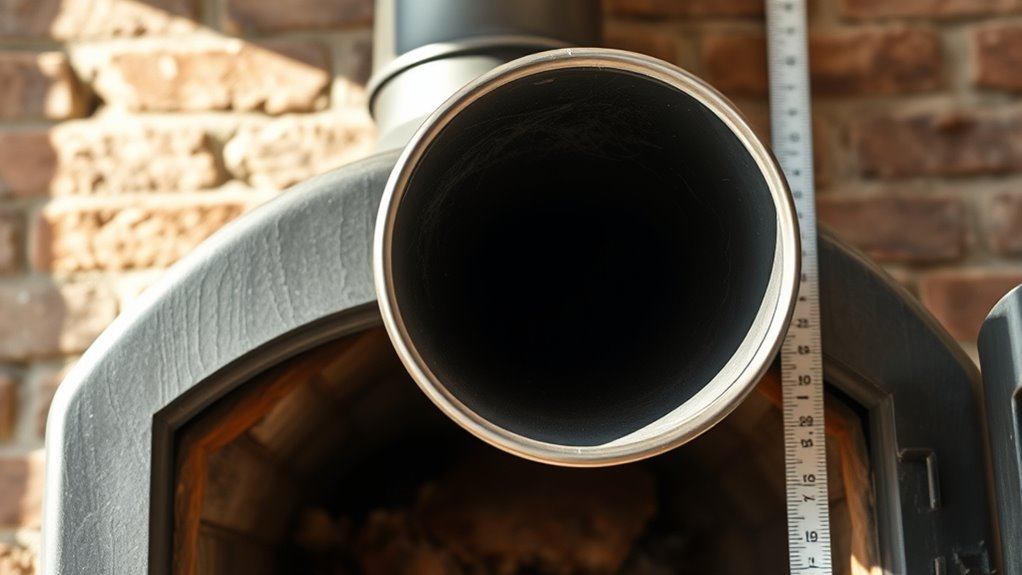
Selecting the correct flue size is essential for ideal stove performance and safety. An undersized flue can cause smoke and dangerous buildup, while an oversized flue reduces efficiency. To determine the right size, consider your stove’s specifications and the diameter of your flue liner. Proper sizing guarantees proper drafting and safe venting. Remember, the chimney cap also plays a role in maintaining airflow and preventing debris. Use the table below to match stove outputs with recommended flue sizes:
| Stove Output (BTU/hr) | Flue Diameter | Recommended Flue Size |
|---|---|---|
| Up to 40,000 | 6 inches | 6-inch flue liner |
| 40,001–80,000 | 8 inches | 8-inch flue liner |
| Over 80,000 | 10 inches | 10-inch flue liner |
Proper sizing guarantees safe, efficient operation. For optimal performance, consider the flue draft, which is influenced by the size and length of your chimney. Understanding chimney efficiency can help you achieve better heating results and energy savings. Additionally, ensuring the flue is correctly sealed and insulated minimizes heat loss and maximizes safety.
The Role of Chimney Height and Placement
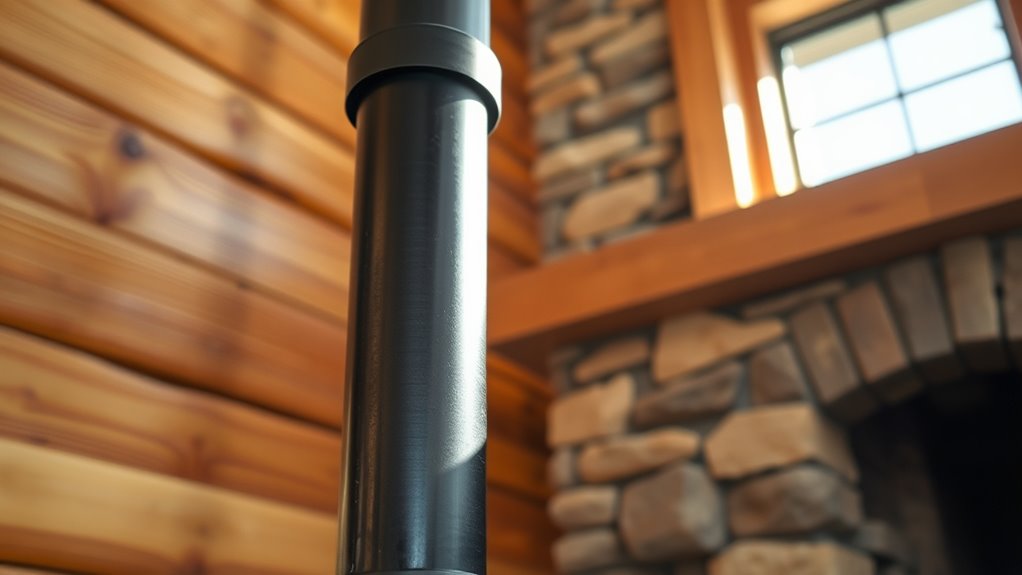
The height and placement of your chimney directly influence how well your stove vents smoke and gases. Proper elevation helps prevent downdrafts and guarantees good draft, while strategic positioning avoids obstructions. Paying attention to these factors keeps your system safe and efficient. Additionally, ensuring the correct chimney height can improve overall performance and prevent issues related to inadequate venting. Using the proper installation techniques is crucial for safety and efficiency during setup. Furthermore, understanding the flue material options can enhance the durability and safety of your chimney system. For optimal hybrid bike performance, selecting components that suit your specific riding needs is essential, especially when considering versatility and speed. Considering home security system benefits can also contribute to safeguarding your property during installation or maintenance activities.
Proper Chimney Elevation
Proper chimney elevation is crucial for ensuring your wood stove functions safely and efficiently. The right chimney height influences draft, prevents smoke backflow, and maximizes flue placement. If your chimney is too short, it can cause poor draft and smoke spillage into your home. Conversely, an excessively tall chimney may be unnecessary and costly. Generally, a chimney should extend at least 3 feet above the roofline and 2 feet above any structure within 10 feet. Proper elevation also ensures proper flue placement, reducing creosote buildup and improving airflow. Keep these points in mind:
- Maintain consistent chimney height for optimal draft
- Ensure flue placement avoids obstructions
- Follow local building codes for minimum height requirements
- Avoid placing the chimney too close to trees or other structures
- Balance height with cost and practicality
- The draft created by appropriate chimney height plays a vital role in the efficient operation of your wood stove.
Optimal Placement Strategies
Achieving ideal chimney placement involves carefully considering both height and location to guarantee your wood stove operates efficiently and safely. Proper placement ensures good draft, reduces smoke spillage, and maintains chimney aesthetics. Think about how your chimney complements your home’s architectural style, especially if you’re aiming for historical designs. The height should be at least 3 feet above the stove and 2 feet above the roof line, but local codes may vary. To balance functionality and visual appeal, consider the table below:
| Placement Factor | Effect |
|---|---|
| Height of Chimney | Improves draft and smoke clearance |
| Location of Chimney | Affects aesthetics and proximity to structures |
Choosing the right spot enhances safety, efficiency, and style. Additionally, understanding the importance of proper venting can significantly influence your chimney’s performance and safety. Ensuring proper venting not only optimizes airflow but also reduces the risk of dangerous creosote buildup, which is a common concern in wood stove chimneys. Regular maintenance and inspection are essential for maintaining optimal chimney safety and preventing potential hazards. Being aware of building codes and regulations can help you comply with safety standards and avoid costly modifications later. Proper chimney design can also contribute to improved overall performance and longevity.
Installation Guidelines for Safety and Efficiency
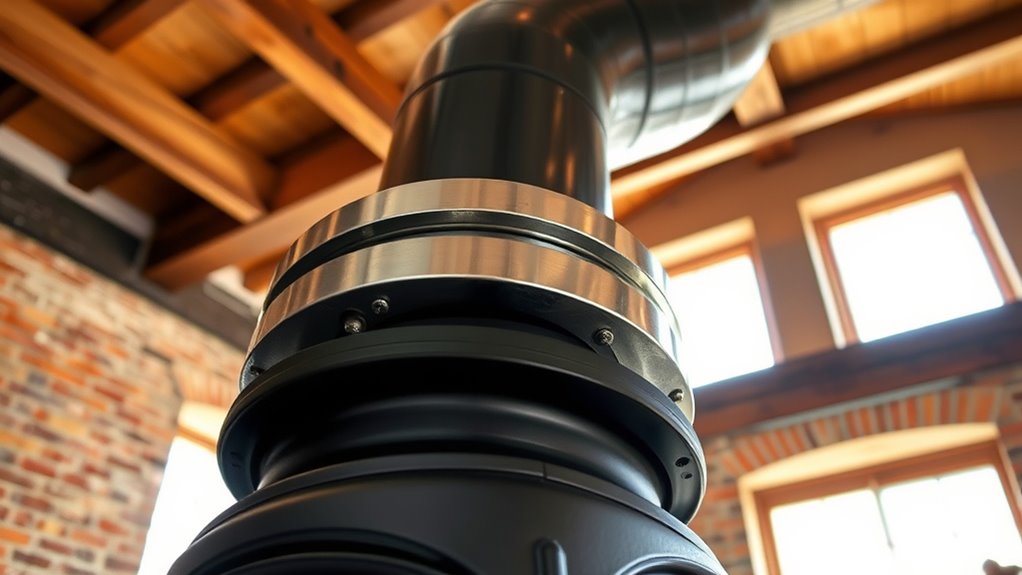
To guarantee your wood stove operates safely and efficiently, you need to follow proper venting procedures and meet material and clearance standards. Regular maintenance is essential to keep everything functioning correctly and prevent hazards. By adhering to these guidelines, you’ll maximize performance and protect your home. Ensuring your chimney and flue are free of sediment formation can help maintain proper airflow and prevent dangerous build-up. Additionally, understanding the importance of digital literacy programs can assist in recognizing potential issues early and maintaining safe operation. Staying informed through hackathon platforms can also provide access to innovative solutions and best practices for modern chimney systems. Being aware of regional legal resources can also be beneficial if you encounter any compliance or safety regulations related to chimney installation and maintenance. Incorporating proper inspection techniques can further ensure ongoing safety and efficiency of your chimney system.
Proper Venting Procedures
Are you confident your wood stove chimney is venting correctly? Proper venting ensures safety and efficiency. Start by checking that your chimney has adequate chimney insulation to prevent heat loss and condensation. Use draft control devices to maintain steady airflow, avoiding smoky fires or poor combustion. Ensure your chimney is free of obstructions and sealed properly at all joints. Regularly inspect for creosote buildup, which can restrict airflow and cause fires. Proper placement of the chimney cap prevents debris and animals from entering. Keep the vent clear of any debris or blockages, and confirm that the flue is appropriately sized for your stove. Adhering to these venting procedures guarantees safe operation and ideal performance of your wood stove.
Material and Clearance Standards
Selecting the right materials and maintaining proper clearances are essential for safe and efficient wood stove installation. Use chimney insulation to prevent heat loss and protect surrounding structures. Choose durable, heat-resistant materials like stainless steel or clay-lined flues that meet safety standards. Ensure your flue sealing is airtight to prevent leaks and ensure proper venting; this reduces creosote buildup and improves efficiency. Follow clearance guidelines specified by local codes, typically maintaining a safe distance from combustible materials, to minimize fire risk. Proper insulation and sealing help maintain consistent airflow, reducing condensation inside the chimney. Additionally, adopting a creative practice mindset can help you approach troubleshooting installation issues with innovative solutions. It is also important to consider material durability to ensure your chimney withstands prolonged exposure to high temperatures and corrosive byproducts. Regular inspection and cleaning are vital components of maintenance protocols that extend the lifespan of your chimney system. Incorporating professional consultation can further ensure compliance with safety standards and optimize system performance. Adhering to these material and clearance standards not only enhances safety but also optimizes your stove’s performance and longevity.
Regular Maintenance Practices
Regular maintenance is essential for keeping your wood stove and chimney operating safely and efficiently. Regularly inspect your chimney insulation to prevent heat loss and ensure proper ventilation. Clean the smoke chamber to remove creosote buildup, reducing fire risk and improving draft. Check for cracks or damage in the chimney liner and repair promptly. Clear any obstructions and ensure all components are secure. Schedule professional inspections annually to identify hidden issues. Maintain the proper clearance around the chimney to prevent heat transfer hazards. Keep the area surrounding your stove tidy to avoid debris buildup. Regular upkeep not only enhances safety but also maximizes fuel efficiency and prolongs your stove’s lifespan. Staying diligent with these practices guarantees your wood stove performs at its best. Additionally, monitoring for pollutant buildup can help detect early signs of inefficiency or hazards, ensuring optimal operation and air quality.
Common Mistakes to Avoid During Installation
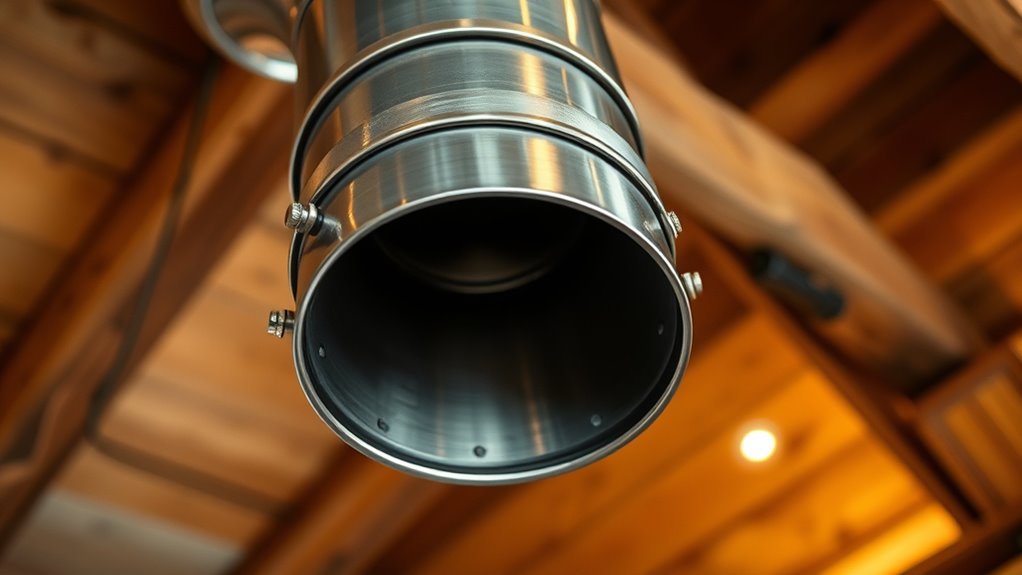
Installing a wood stove chimney requires careful attention to detail, as mistakes can compromise safety and efficiency. One common error is neglecting to install a proper chimney cap, which prevents debris, animals, and rain from entering the flue. Skipping this step can lead to blockages or water damage. Additionally, improper draft control setup can cause poor airflow, resulting in inefficient burning or smoke backup inside your home. Make sure your chimney is correctly aligned and sealed to avoid leaks that can reduce draft and increase fire risk. Avoid shortcuts like using incompatible materials or ignoring local building codes. Proper installation guarantees your chimney functions safely and efficiently, giving you peace of mind while enjoying your wood stove.
Maintenance and Inspection of Your Wood Stove Chimney
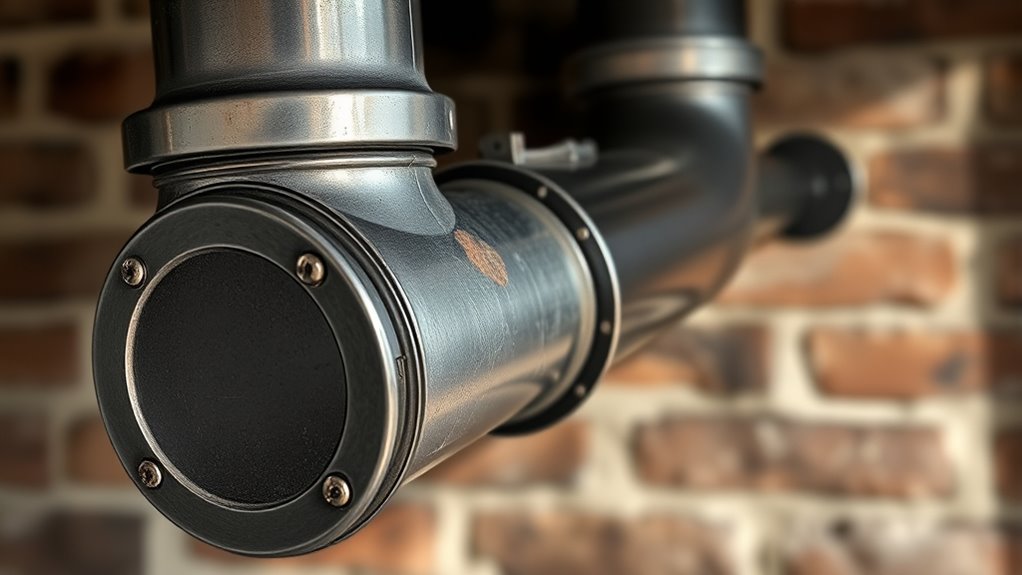
To keep your chimney working safely and efficiently, you need to follow a regular cleaning schedule. Look out for blockages and signs of damage that could cause problems or fire hazards. Regular inspections help you catch issues early and guarantee your chimney stays in good shape.
Regular Cleaning Schedule
Maintaining a consistent cleaning schedule is essential to guarantee your wood stove chimney functions safely and efficiently. Regular chimney cleaning helps prevent dangerous soot buildup that can hinder airflow and increase fire risks. Set a routine based on your usage, typically once or twice a year, or more if you burn frequently. During cleanings, check for creosote deposits and remove any debris. Staying on top of chimney maintenance also extends the lifespan of your stove and improves heating performance.
- Inspect for creosote and soot buildup
- Schedule professional chimney cleaning when needed
- Remove blockages and debris regularly
- Check for signs of corrosion or damage
- Keep a cleaning log for future reference
Detecting Chimney Blockages
How can you tell if your chimney is blocked? If you notice smoke isn’t venting properly or your wood stove produces excessive smoke, you might have chimney obstructions. Poor smoke venting can cause smoke to back up into your home or create a strong odor. Another sign is a downdraft, where smoke flows back into the room instead of exiting through the chimney. You may also see soot or creosote buildup around the chimney cap or stovepipe. Regularly inspecting your chimney for signs of blockages helps prevent dangerous creosote fires and ensures efficient operation. If you suspect a blockage, avoid using your stove until it’s cleared, and consider calling a professional for a thorough inspection and cleaning.
Inspecting for Damage
Regularly inspecting your chimney for damage is essential to keep your wood stove operating safely and efficiently. Over time, chimney soot buildup can obscure damage, while flue corrosion may weaken the structure. During inspections, look for signs of deterioration or blockages that could cause dangerous emissions or fire hazards.
Key items to check include:
- Excessive chimney soot buildup
- Signs of flue corrosion or rust
- Cracks or gaps in the chimney lining
- Loose or damaged chimney caps
- Any visible rust or discoloration
Addressing these issues promptly helps prevent dangerous leaks, improves airflow, and maintains safety. Regular inspections ensure your chimney remains in good condition, reducing the risk of smoke backflow or chimney fires.
Enhancing Performance With Proper Venting Techniques
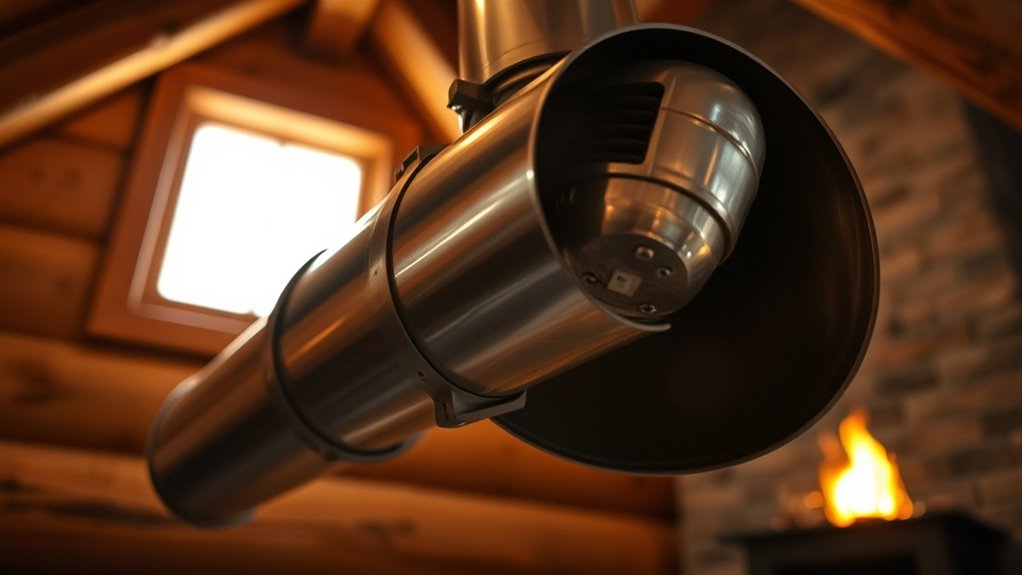
Proper venting is essential for maximizing your wood stove’s efficiency and safety. A well-designed chimney cap can improve draft, prevent downdrafts, and keep debris out, boosting overall performance. When choosing a chimney cap design, consider models that promote proper airflow and resist weather elements. Additionally, exploring different flue liner options can ensure enhance venting efficiency. Insulated liners help maintain consistent temperatures, reducing creosote buildup and improving draw. Properly sealing and aligning your venting system ensures smooth exhaust flow, minimizing smoke and emissions inside your home. Regular maintenance of your chimney cap and flue liner keeps venting optimal, preventing blockages and fire hazards. By paying attention to these venting techniques, you’ll ensure your wood stove operates safely, efficiently, and with better heat output.
Regulations and Codes for Wood Stove Chimney Installation
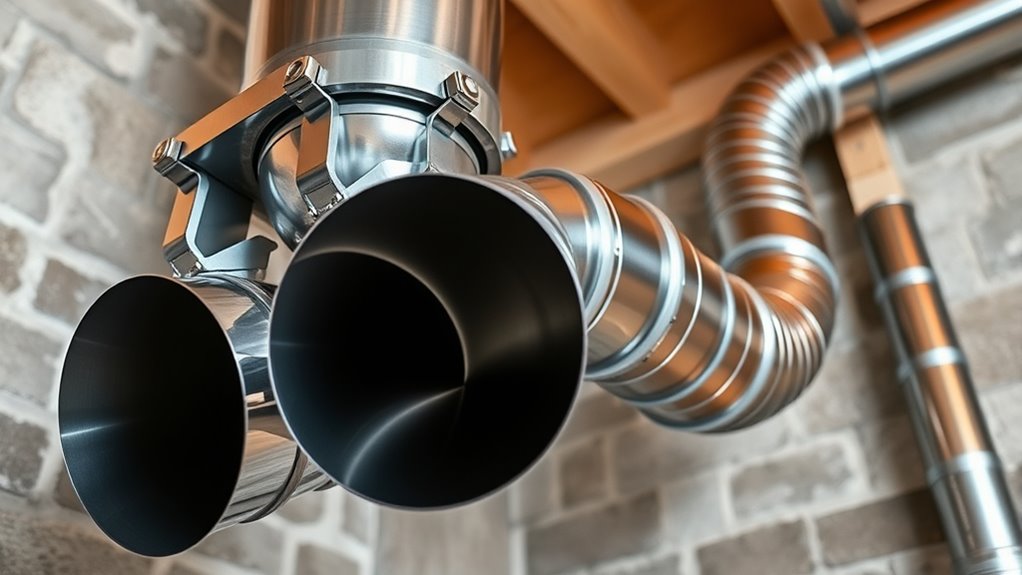
Installing a wood stove chimney requires careful adherence to local building codes and regulations to guarantee safety and compliance. These rules ensure proper venting, prevent fire hazards, and promote efficient operation. You must consider regulations regarding chimney height, clearance from combustibles, and proper insulation, such as chimney insulation, to prevent heat loss and ensure safety. Additionally, codes often specify requirements for the smoke chamber, which must be properly constructed to direct smoke safely out of your home. You’ll also need to ensure your chimney pass inspection and meet manufacturer guidelines. Ignoring these codes can lead to unsafe conditions or failed inspections, so always consult local authorities or a professional. Staying compliant protects your home and family while maintaining ideal stove performance.
Frequently Asked Questions
How Often Should I Have My Chimney Professionally Inspected?
You should have your chimney professionally inspected at least once a year to guarantee proper chimney maintenance and safety. Regular safety inspections help identify creosote buildup, blockages, or damage that could cause chimney fires or carbon monoxide leaks. If you use your fireplace or stove frequently, consider more frequent inspections. Staying on top of these checks keeps your home safe and your chimney functioning efficiently.
What Are Signs of Chimney Blockages or Leaks?
You should watch for signs of chimney blockages or leaks, like excessive creosote buildup, which can cause dangerous fires, or cracked chimney masonry that might let leaks develop. If you notice smoke spilling into your home, strong odors, or water leaks around the chimney, it’s time to inspect and clean your chimney. Regular checks help prevent problems and keep your stove operating safely and efficiently.
Can I Install a Chimney Liner Myself?
Did you know that improper chimney installation can increase fire risks by up to 50%? When it comes to chimney safety, DIY installation might seem tempting, but it’s risky unless you’re experienced. Installing a chimney liner requires precise measurements, proper sealing, and adherence to safety codes. If you’re unsure, it’s best to hire a professional to guarantee your chimney remains safe, effective, and compliant with regulations.
How Does Weather Affect Chimney Performance?
Weather impact plays a significant role in your chimney’s performance, especially during seasonal changes. Cold, windy, and rainy weather can cause draft issues, leading to poor venting or smoke backflow. Snow and ice may block the flue or cause damage. To guarantee your chimney functions properly year-round, you should inspect and maintain it regularly, especially before winter, and consider adding weatherproofing measures like chimney caps or dampers.
Are There Eco-Friendly Options for Chimney Materials?
Like planting a tree for future generations, choosing eco-friendly alternatives for your chimney shows care for the planet. You can opt for sustainable chimney materials such as recycled metal or ceramic composites, which reduce environmental impact. These sustainable chimney materials not only lower your carbon footprint but also enhance durability. By making mindful choices, you guarantee your home stays warm while contributing to a healthier Earth.
Conclusion
Choosing and installing the right chimney guarantees your wood stove operates safely and efficiently. While it might seem complex, investing time now prevents costly issues later. Don’t overlook proper sizing, placement, or maintenance—these details keep your home warm and safe. Remember, a well-chosen flue isn’t just about performance; it’s about peace of mind. Trust the process, follow regulations, and enjoy the cozy comfort knowing your chimney is built to last.

